| The Deep Sea Abyss - Part II |
| The Dragon fish |
Considered top predators of the abyss, Stomiidae such as dragonfish and viperfish are
sleek, aggressive hunters equipped not only with bioluminescent lures but with unique,
red-tinted photophores behind their eyes. Relatively fewer creatures in the deep can see red
light, allowing these fish to illuminate their field of vision without betraying their presence to
most other animals. Though hardly so extreme as the anglers, males are much smaller and
relatively simpler than the females, without lures or even teeth. It is commonly believed that
mature males do not feed, but live only to mate and die in the manner of many insects.
sleek, aggressive hunters equipped not only with bioluminescent lures but with unique,
red-tinted photophores behind their eyes. Relatively fewer creatures in the deep can see red
light, allowing these fish to illuminate their field of vision without betraying their presence to
most other animals. Though hardly so extreme as the anglers, males are much smaller and
relatively simpler than the females, without lures or even teeth. It is commonly believed that
mature males do not feed, but live only to mate and die in the manner of many insects.
| Written by Jonathan C. Wojcik - Photo credits unknown or from public news articles unless otherwise noted. If you know their sources and need them credited or removed, please e-mail me. |


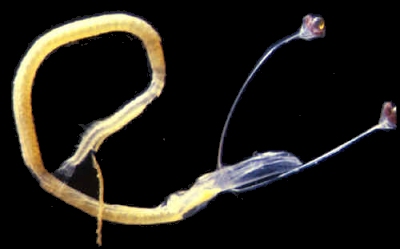
In some species, larvae possess eyes on long, flexible stalks, giving them a wider range of
vision.The stalks are slowly "reeled in" as the animal matures, and still present - tightly
coiled - in the skulls of adults.
vision.The stalks are slowly "reeled in" as the animal matures, and still present - tightly
coiled - in the skulls of adults.
Some members of the Stomiidae are known as "loosejaws" or "rat trap fish" for their oddly
structured lower jaws, which reach out at prey like the claws of a mantis and have open,
skinless floors to reduce drag in the water.
structured lower jaws, which reach out at prey like the claws of a mantis and have open,
skinless floors to reduce drag in the water.
| Photo by Edith Widder, drawing by myself. |
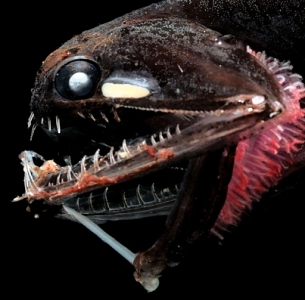
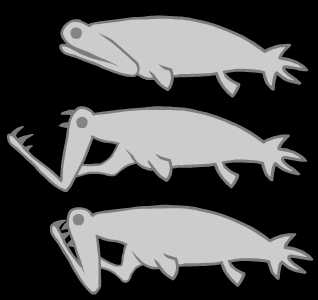
| The Gulpers and Swallowers |
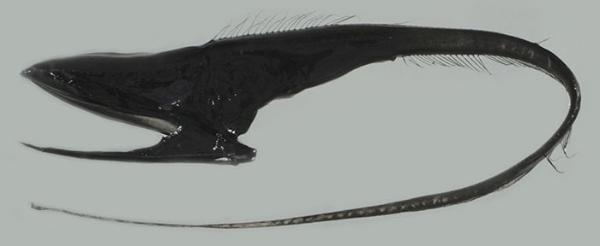
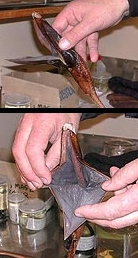
Another famous icon of the deep, members of the
Saccopharyngiformes (literally "sack throats") are sometimes
known as "pelican eels," "umbrellamouth gulpers" or simply
"gulper eels."
Not technically eels, these elongated fish have thin, flexible
jaws that unfold like an umbrella to engulf prey that may be
greater than their own total mass, with incredibly stretchy
throats and stomachs to store and digest a high volume of
food.
In some species, the tip of the tail ends in a tiny light that may
be dangled in the mouth as a lure.
Saccopharyngiformes (literally "sack throats") are sometimes
known as "pelican eels," "umbrellamouth gulpers" or simply
"gulper eels."
Not technically eels, these elongated fish have thin, flexible
jaws that unfold like an umbrella to engulf prey that may be
greater than their own total mass, with incredibly stretchy
throats and stomachs to store and digest a high volume of
food.
In some species, the tip of the tail ends in a tiny light that may
be dangled in the mouth as a lure.
| The Tripods |
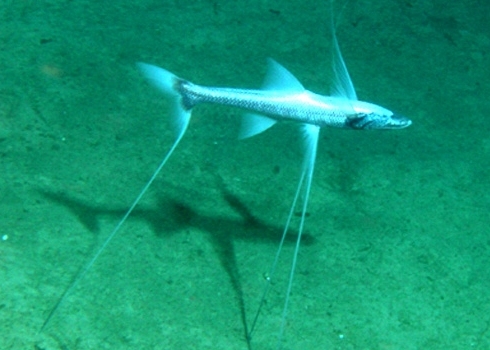
Though its body is just over a foot in length, Bathypterois grallator stands up to a meter off
the sea floor on three fins with incredibly elongated tips. Swimming only when necessary, it
spends most of its times standing in a single spot, eating whatever tiny creatures may bump
into its outstretched front fins. Like several other deep-sea fish, tripods are hermaphrodites,
and capable of self fertilization.
the sea floor on three fins with incredibly elongated tips. Swimming only when necessary, it
spends most of its times standing in a single spot, eating whatever tiny creatures may bump
into its outstretched front fins. Like several other deep-sea fish, tripods are hermaphrodites,
and capable of self fertilization.
| Snipe Eels |
With its incredibly thin, threadlike body, Nemichthys scolopaceus is a fish that can grow up
to five feet in length and weigh only a few ounces. Their thin jaws curve away from one
another in a seemingly useless fashion, but are lined with minute, backwards-pointing teeth
adapted for snagging the antennae of passing shrimp. The jaws are then worked in a
"ratchet like" manner, pulling the prey farther along the tiny hooks.
to five feet in length and weigh only a few ounces. Their thin jaws curve away from one
another in a seemingly useless fashion, but are lined with minute, backwards-pointing teeth
adapted for snagging the antennae of passing shrimp. The jaws are then worked in a
"ratchet like" manner, pulling the prey farther along the tiny hooks.

| Grideyes |
Species in the genus Ipnops of the Ipnopidae have never been observed in the wild and
their habits are largely unknown, as is the purpose of their incredibly bizarre, highly modified
eyes. These flat, grid-like structures call to mind the eyes of an insect or the cockpit of a
helicopter, and appear to be bioluminescent for purposes we can only guess at.
their habits are largely unknown, as is the purpose of their incredibly bizarre, highly modified
eyes. These flat, grid-like structures call to mind the eyes of an insect or the cockpit of a
helicopter, and appear to be bioluminescent for purposes we can only guess at.
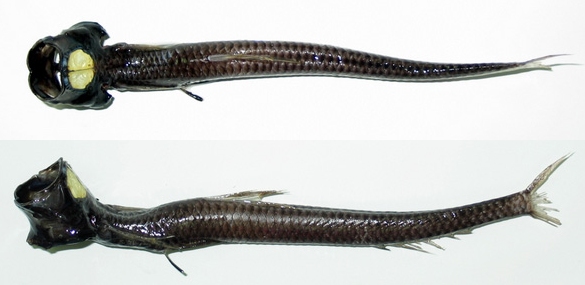
| Blob Sculpins |
Somewhere between a flying saucer and a naked chicken, these bizarre, big-nosed animals
are actually a group of anglers separate from the luminous Certaoids. Their lures, housed in
nostril-like pits above the mouth, produce no light but are believed to attract other animals by
scent. These creatures can actually be found even in shallower water, where they often take
on a more colorful appearance. When disturbed, some species can inflate like a blowfish.
are actually a group of anglers separate from the luminous Certaoids. Their lures, housed in
nostril-like pits above the mouth, produce no light but are believed to attract other animals by
scent. These creatures can actually be found even in shallower water, where they often take
on a more colorful appearance. When disturbed, some species can inflate like a blowfish.
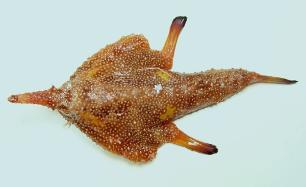

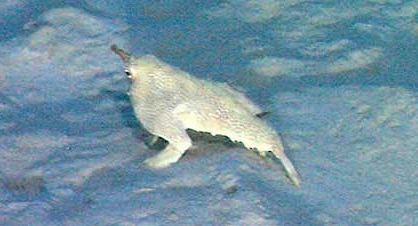
Anglers may be the most famous inhabitants of the Abyssopelagic, but its wide variety of other fish
take on equally outlandish shapes, sometimes challenging our very understanding of zoology.
take on equally outlandish shapes, sometimes challenging our very understanding of zoology.
These are only a fraction of the peculiar bony fish that inhabit these inky trenches; over the
proceeding pages, we'll talk about how several other animal groups have adapted to this
wild environment.
proceeding pages, we'll talk about how several other animal groups have adapted to this
wild environment.

This comical puddle of flesh has become one of the most popular photographs of any
deep-sea animal on the internet, featured on innumerable "top weirdest animal" lists. Of
course, this poor blob sculpin only looks this way because it has been brought to the
surface. Like a jellyfish, the density of its body is slightly less than that of water and holds a
more consistent shape in its natural environment.
deep-sea animal on the internet, featured on innumerable "top weirdest animal" lists. Of
course, this poor blob sculpin only looks this way because it has been brought to the
surface. Like a jellyfish, the density of its body is slightly less than that of water and holds a
more consistent shape in its natural environment.
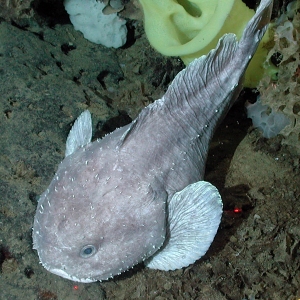
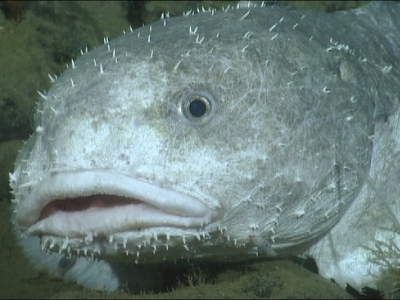
Disappointing though it may be, the Psychrolutidae or "fatheads" look fairly mundane in the
ocean, though certainly unusual for Scorpaeniformes, which include the stonefish and
beautiful lionfish of brighter waters. Adapted to expend as little energy as possible, they
swallow whatever food just happens to drift close enough. Unusually for abyss-dwellers, they
have been observed carefully protecting their eggs and young in community nesting sites.
ocean, though certainly unusual for Scorpaeniformes, which include the stonefish and
beautiful lionfish of brighter waters. Adapted to expend as little energy as possible, they
swallow whatever food just happens to drift close enough. Unusually for abyss-dwellers, they
have been observed carefully protecting their eggs and young in community nesting sites.
| Snailfish |
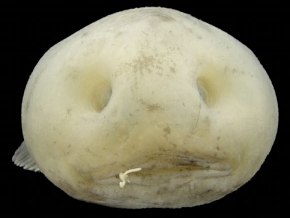

| Unknown species - maybe a larva? |

Somewhat related to the blobfish but quite a bit odder, the snailfish are so named for their
slimy, simplistic bodies. Species throughout the sea exhibit strange and seemingly
degenerate behavior, one variety even living its entire life within the body of a scallop. In the
deep sea abyss, they've taken to peculiar nesting habits, routinely laying their eggs in the gill
chambers of giant crabs. As they cause no direct harm to the Crustaceans, this relationship
is not parasitic, and may even be a mutual symbiosis as the fish eat bits of refuse and
parasites off the crab's body.
slimy, simplistic bodies. Species throughout the sea exhibit strange and seemingly
degenerate behavior, one variety even living its entire life within the body of a scallop. In the
deep sea abyss, they've taken to peculiar nesting habits, routinely laying their eggs in the gill
chambers of giant crabs. As they cause no direct harm to the Crustaceans, this relationship
is not parasitic, and may even be a mutual symbiosis as the fish eat bits of refuse and
parasites off the crab's body.
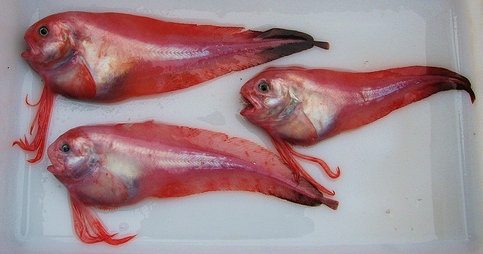
| Walking Bat-fish |
| Three in One |
Many fish undergo dramatic metamorphosis and display extreme variation between sexes,
which can sometimes be confused as individual species. One fish, however, varies wildly
enough to have been mistaken for three distinct families.
which can sometimes be confused as individual species. One fish, however, varies wildly
enough to have been mistaken for three distinct families.
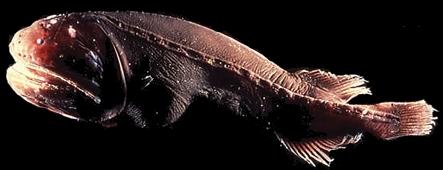
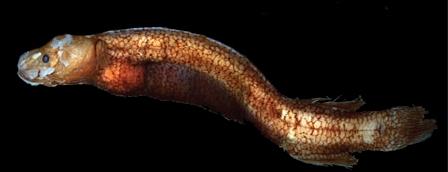

Larvae are known as "tapetails," and were once classified as the family Mirapinnidae.
They were known to be larvae by their lack of reproductive organs, but it was not known
what sort of fish they matured into. They make their home closer to the ocean's surface,
and gorge on food to store energy in a massive liver.
They were known to be larvae by their lack of reproductive organs, but it was not known
what sort of fish they matured into. They make their home closer to the ocean's surface,
and gorge on food to store energy in a massive liver.
As tapetails descend to the abyss, some mature into male forms called "bignoses,"
formerly the family Megalommycteridae. Lacking a stomach or throat, they are sustained
only by the nutrients they stockpiled as larvae.
formerly the family Megalommycteridae. Lacking a stomach or throat, they are sustained
only by the nutrients they stockpiled as larvae.
Females, finally, were named the Cetomimidae or "Whalefish." Larger and longer lived
than males, they eat any small fish that comes within gulping distance - and may even have
tooth-lined gills to serve as additional mouths.
than males, they eat any small fish that comes within gulping distance - and may even have
tooth-lined gills to serve as additional mouths.
| Barreleyes |
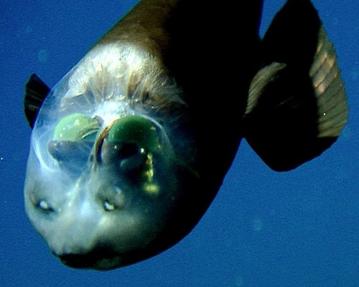
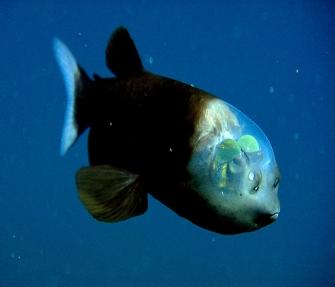
Photographed alive for the first time in 2009, this species of "barreleye" or "spookfish"
houses its rotating eyeballs beneath a dome of transparent tissue. It has been speculated
that the fish steals food from the tentacles of Siphonophores (see the following page,
below!) and uses this remarkable bubble-head to shield its eyes from their stinging cells.
houses its rotating eyeballs beneath a dome of transparent tissue. It has been speculated
that the fish steals food from the tentacles of Siphonophores (see the following page,
below!) and uses this remarkable bubble-head to shield its eyes from their stinging cells.
| Images © MBARI |
| Images © 2004 MBARI |